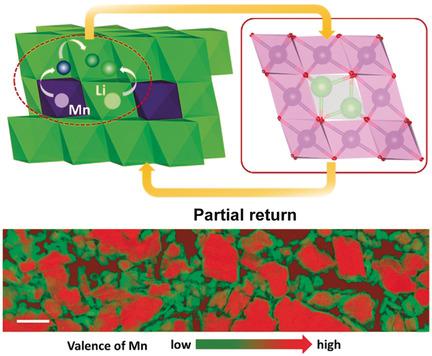当前位置:
X-MOL 学术
›
Angew. Chem. Int. Ed.
›
论文详情
Our official English website, www.x-mol.net, welcomes your
feedback! (Note: you will need to create a separate account there.)
Size-Mediated Recurring Spinel Sub-nanodomains in Li- and Mn-Rich Layered Cathode Materials.
Angewandte Chemie International Edition ( IF 16.1 ) Pub Date : 2020-05-28 , DOI: 10.1002/anie.202005337 Biwei Xiao 1 , Hanshuo Liu 2 , Ning Chen 3 , Mohammad Norouzi Banis 1 , Haijun Yu 4 , Jianwen Liang 1 , Qian Sun 1 , Tsun-Kong Sham 5 , Ruying Li 1 , Mei Cai 6 , Gianluigi A Botton 2, 3 , Xueliang Sun 1
Angewandte Chemie International Edition ( IF 16.1 ) Pub Date : 2020-05-28 , DOI: 10.1002/anie.202005337 Biwei Xiao 1 , Hanshuo Liu 2 , Ning Chen 3 , Mohammad Norouzi Banis 1 , Haijun Yu 4 , Jianwen Liang 1 , Qian Sun 1 , Tsun-Kong Sham 5 , Ruying Li 1 , Mei Cai 6 , Gianluigi A Botton 2, 3 , Xueliang Sun 1
Affiliation

|
Li‐ and Mn‐rich layered oxides are among the most promising cathode materials for Li‐ion batteries with high theoretical energy density. Its practical application is, however, hampered by the capacity and voltage fade after long cycling. Herein, a finite difference method for near‐edge structure (FDMNES) code was combined with in situ X‐ray absorption spectroscopy (XAS) and transmission electron microscopy/electron energy loss spectroscopy (TEM/EELS) to investigate the evolution of transition metals (TMs) in fresh and heavily cycled electrodes. Theoretical modeling reveals a recurring partially reversible LiMn2O4‐like sub‐nanodomain formation/dissolution process during each charge/discharge, which accumulates gradually and accounts for the Mn phase transition. From the modeling of spectra and maps of the valence state over large regions of the cathodes, it was found that the phase change is size‐dependent. After prolonged cycling, the TMs displayed different levels of inactivity.
中文翻译:

富含Li和Mn的层状阴极材料中尺寸介导的重复尖晶石亚纳米域。
富含锂和锰的层状氧化物是具有高理论能量密度的锂离子电池最有希望的正极材料之一。然而,它的实际应用受到长时间循环后的容量和电压衰减的阻碍。本文将近边缘结构的有限差分法(FDMNES)与原位X射线吸收光谱(XAS)和透射电子显微镜/电子能量损失光谱(TEM / EELS)结合起来研究过渡金属的演变( TMs)在新鲜且循环频繁的电极中。理论建模揭示了部分可逆的重复发生的LiMn 2 O 4每次充电/放电过程中类似亚纳米域的形成/溶解过程,逐渐积累并解释了Mn相变。通过对阴极大区域上的价态光谱和谱图进行建模,发现相变与尺寸有关。长时间循环后,TM表现出不同程度的不活动状态。
更新日期:2020-05-28
中文翻译:

富含Li和Mn的层状阴极材料中尺寸介导的重复尖晶石亚纳米域。
富含锂和锰的层状氧化物是具有高理论能量密度的锂离子电池最有希望的正极材料之一。然而,它的实际应用受到长时间循环后的容量和电压衰减的阻碍。本文将近边缘结构的有限差分法(FDMNES)与原位X射线吸收光谱(XAS)和透射电子显微镜/电子能量损失光谱(TEM / EELS)结合起来研究过渡金属的演变( TMs)在新鲜且循环频繁的电极中。理论建模揭示了部分可逆的重复发生的LiMn 2 O 4每次充电/放电过程中类似亚纳米域的形成/溶解过程,逐渐积累并解释了Mn相变。通过对阴极大区域上的价态光谱和谱图进行建模,发现相变与尺寸有关。长时间循环后,TM表现出不同程度的不活动状态。











































 京公网安备 11010802027423号
京公网安备 11010802027423号